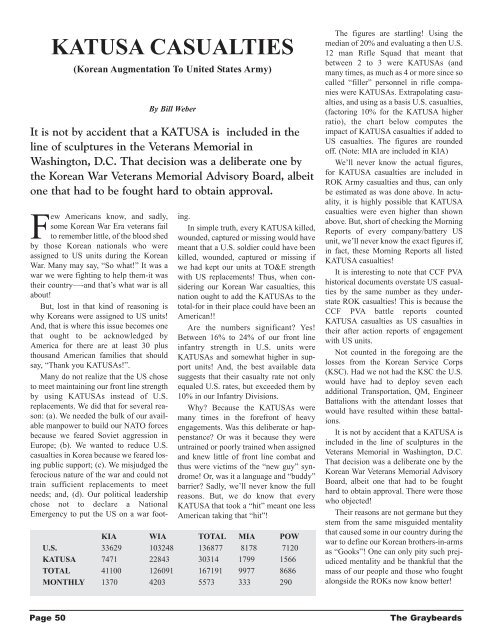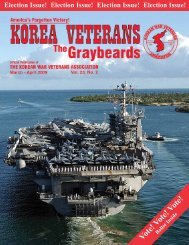The Graybeards - KWVA - Korean War Veterans Association
The Graybeards - KWVA - Korean War Veterans Association
The Graybeards - KWVA - Korean War Veterans Association
Create successful ePaper yourself
Turn your PDF publications into a flip-book with our unique Google optimized e-Paper software.
KATUSA CASUALTIES<br />
(<strong>Korean</strong> Augmentation To United States Army)<br />
By Bill Weber<br />
It is not by accident that a KATUSA is included in the<br />
line of sculptures in the <strong>Veterans</strong> Memorial in<br />
Washington, D.C. That decision was a deliberate one by<br />
the <strong>Korean</strong> <strong>War</strong> <strong>Veterans</strong> Memorial Advisory Board, albeit<br />
one that had to be fought hard to obtain approval.<br />
Few Americans know, and sadly,<br />
some <strong>Korean</strong> <strong>War</strong> Era veterans fail<br />
to remember little, of the blood shed<br />
by those <strong>Korean</strong> nationals who were<br />
assigned to US units during the <strong>Korean</strong><br />
<strong>War</strong>. Many may say, “So what!” It was a<br />
war we were fighting to help them-it was<br />
their country—-and that’s what war is all<br />
about!<br />
But, lost in that kind of reasoning is<br />
why <strong>Korean</strong>s were assigned to US units!<br />
And, that is where this issue becomes one<br />
that ought to be acknowledged by<br />
America for there are at least 30 plus<br />
thousand American families that should<br />
say, “Thank you KATUSAs!”.<br />
Many do not realize that the US chose<br />
to meet maintaining our front line strength<br />
by using KATUSAs instead of U.S.<br />
replacements. We did that for several reason:<br />
(a). We needed the bulk of our available<br />
manpower to build our NATO forces<br />
because we feared Soviet aggression in<br />
Europe; (b). We wanted to reduce U.S.<br />
casualties in Korea because we feared losing<br />
public support; (c). We misjudged the<br />
ferocious nature of the war and could not<br />
train sufficient replacements to meet<br />
needs; and, (d). Our political leadership<br />
chose not to declare a National<br />
Emergency to put the US on a war footing.<br />
In simple truth, every KATUSA killed,<br />
wounded, captured or missing would have<br />
meant that a U.S. soldier could have been<br />
killed, wounded, captured or missing if<br />
we had kept our units at TO&E strength<br />
with US replacements! Thus, when considering<br />
our <strong>Korean</strong> <strong>War</strong> casualties, this<br />
nation ought to add the KATUSAs to the<br />
total-for in their place could have been an<br />
American!!<br />
Are the numbers significant? Yes!<br />
Between 16% to 24% of our front line<br />
infantry strength in U.S. units were<br />
KATUSAs and somewhat higher in support<br />
units! And, the best available data<br />
suggests that their casualty rate not only<br />
equaled U.S. rates, but exceeded them by<br />
10% in our Infantry Divisions.<br />
Why? Because the KATUSAs were<br />
many times in the forefront of heavy<br />
engagements. Was this deliberate or happenstance?<br />
Or was it because they were<br />
untrained or poorly trained when assigned<br />
and knew little of front line combat and<br />
thus were victims of the “new guy” syndrome!<br />
Or, was it a language and “buddy”<br />
barrier? Sadly, we’ll never know the full<br />
reasons. But, we do know that every<br />
KATUSA that took a “hit” meant one less<br />
American taking that “hit”!<br />
KIA WIA TOTAL MIA POW<br />
U.S. 33629 103248 136877 8178 7120<br />
KATUSA 7471 22843 30314 1799 1566<br />
TOTAL 41100 126091 167191 9977 8686<br />
MONTHLY 1370 4203 5573 333 290<br />
<strong>The</strong> figures are startling! Using the<br />
median of 20% and evaluating a then U.S.<br />
12 man Rifle Squad that meant that<br />
between 2 to 3 were KATUSAs (and<br />
many times, as much as 4 or more since so<br />
called “filler” personnel in rifle companies<br />
were KATUSAs. Extrapolating casualties,<br />
and using as a basis U.S. casualties,<br />
(factoring 10% for the KATUSA higher<br />
ratio), the chart below computes the<br />
impact of KATUSA casualties if added to<br />
US casualties. <strong>The</strong> figures are rounded<br />
off. (Note: MIA are included in KIA)<br />
We’ll never know the actual figures,<br />
for KATUSA casualties are included in<br />
ROK Army casualties and thus, can only<br />
be estimated as was done above. In actuality,<br />
it is highly possible that KATUSA<br />
casualties were even higher than shown<br />
above. But, short of checking the Morning<br />
Reports of every company/battery US<br />
unit, we’ll never know the exact figures if,<br />
in fact, these Morning Reports all listed<br />
KATUSA casualties!<br />
It is interesting to note that CCF PVA<br />
historical documents overstate US casualties<br />
by the same number as they understate<br />
ROK casualties! This is because the<br />
CCF PVA battle reports counted<br />
KATUSA casualties as US casualties in<br />
their after action reports of engagement<br />
with US units.<br />
Not counted in the foregoing are the<br />
losses from the <strong>Korean</strong> Service Corps<br />
(KSC). Had we not had the KSC the U.S.<br />
would have had to deploy seven each<br />
additional Transportation, QM, Engineer<br />
Battalions with the attendant losses that<br />
would have resulted within these battalions.<br />
It is not by accident that a KATUSA is<br />
included in the line of sculptures in the<br />
<strong>Veterans</strong> Memorial in Washington, D.C.<br />
That decision was a deliberate one by the<br />
<strong>Korean</strong> <strong>War</strong> <strong>Veterans</strong> Memorial Advisory<br />
Board, albeit one that had to be fought<br />
hard to obtain approval. <strong>The</strong>re were those<br />
who objected!<br />
<strong>The</strong>ir reasons are not germane but they<br />
stem from the same misguided mentality<br />
that caused some in our country during the<br />
war to define our <strong>Korean</strong> brothers-in-arms<br />
as “Gooks”! One can only pity such prejudiced<br />
mentality and be thankful that the<br />
mass of our people and those who fought<br />
alongside the ROKs now know better!<br />
Page 50<br />
<strong>The</strong> <strong>Graybeards</strong>
















